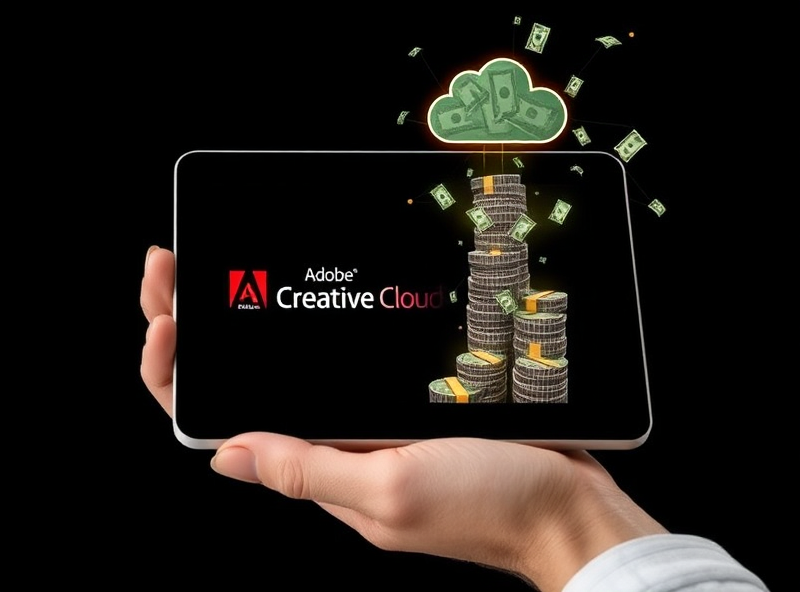
Adobe (ADBE) Stock: Is This Creative Software Giant Still a Smart Investment?

Hello, fellow investors and creative minds! When you think about the tools that power the world’s digital creativity – from stunning photographs and captivating videos to professional designs and engaging websites – one company stands out: Adobe. With its suite of industry-standard software like Photoshop, Illustrator, Premiere Pro, and Acrobat, Adobe Inc. (ADBE) has become synonymous with creative and digital work. As a dominant force in the software industry, Adobe’s stock is often a focus for investors. You might use their products yourself and wonder, “Is this company that seems so essential still a good investment?” or perhaps, “Given its size and success, is Adobe stock still a smart place to put my money, or has its best growth already happened?” These are excellent questions that get to the heart of investing in established technology leaders! The purpose of this article is to take a friendly, in-depth look at Adobe (ADBE) stock, exploring what makes the company so powerful, the factors that could drive its future, the challenges and competitive pressures it faces, and what you should consider when deciding if it fits into your investment portfolio. Let’s explore whether this creative software giant remains a smart investment opportunity today.
Understanding Adobe’s Digital Empire
Adobe Inc. is a global software company that provides a wide range of products and services used by creative professionals, marketers, businesses, and consumers. While its roots are in desktop publishing and graphic design, Adobe has successfully transformed itself into a cloud-based software-as-a-service (SaaS) company with a diverse portfolio. Its business is primarily organized into two major clouds:
- Digital Media: This is where Adobe’s famous creative tools reside. It includes the Creative Cloud, which offers subscription access to software like Photoshop (image editing), Illustrator (vector graphics), Premiere Pro (video editing), After Effects (motion graphics), InDesign (page design), and many others. It also includes the Document Cloud, centered around Acrobat (PDF creation and editing) and related services for document workflows. This segment serves creative professionals, students, and businesses of all sizes.
- Digital Experience: This segment provides a suite of software and services for marketing, advertising, analytics, and e-commerce. Known as the Adobe Experience Cloud, it helps businesses manage customer relationships, personalize marketing campaigns, analyze customer data, and build online commerce platforms. This segment serves marketing professionals and large enterprises looking to enhance their digital presence and customer interactions.
The company’s successful transition from selling perpetual software licenses (where you buy the software once) to a subscription model (where you pay a recurring fee, usually monthly or annually, to use the software) has been a key driver of its growth and financial stability. The subscription model provides predictable, recurring revenue and fosters a closer, ongoing relationship with customers.
Adobe’s Strengths: Why It Might Still Be a Smart Investment
Adobe possesses several powerful strengths that have allowed it to maintain a dominant position and could continue to make it a smart investment for the right portfolio:
- Dominant Market Position and Ecosystem: In the creative software industry, Adobe’s Creative Cloud suite is the undisputed standard. Photoshop, Illustrator, and Premiere Pro are the go-to tools for millions of professionals worldwide. This creates a powerful ecosystem effect: professionals learn and rely on Adobe tools, schools teach them, and businesses require employees to be proficient in them. This makes it difficult for competitors to gain significant traction and creates high switching costs for users and organizations.
- Sticky Subscription Model: The subscription model provides Adobe with a highly predictable and recurring revenue stream. Once users are integrated into the Creative Cloud workflow, the value they derive from the suite often makes the ongoing subscription cost worthwhile, leading to high customer retention rates. This recurring revenue provides financial stability and visibility.
- Strong Brand Loyalty: Adobe has built immense brand loyalty over decades. Its products are trusted and recognized globally as the benchmark for quality and functionality in creative and document workflows.
- Expansion into Digital Experience: The Digital Experience segment represents a significant growth area for Adobe. As businesses increasingly focus on digital transformation, customer experience, and data-driven marketing, the demand for Adobe’s Experience Cloud solutions is growing. This segment diversifies Adobe’s revenue streams beyond just creative professionals and taps into the large enterprise market.
- Integration of AI: Adobe is actively integrating Artificial Intelligence (AI), particularly through its “Adobe Sensei” framework and newer generative AI features (like Firefly), into its products. AI has the potential to enhance the capabilities of creative tools, automate tasks, and provide new functionalities in both the Digital Media and Digital Experience segments. Successful AI integration could strengthen its competitive position and create new value for users.
- Global Reach: Adobe has a strong global presence, selling its products and services to customers in countries around the world. This provides a large addressable market and opportunities for international growth.
- Profitability and Cash Flow: Adobe has historically been a highly profitable company with strong operating margins and consistent generation of free cash flow. This financial strength provides resources for R&D, acquisitions, and returning value to shareholders.
These strengths highlight Adobe’s powerful competitive moat, its successful business model transition, and its potential for continued growth in both creative and enterprise software markets.
Challenges and Risks: Why It Might Be a Risky Bet
Despite its strengths, investing in Adobe comes with significant challenges and risks that could make it a “risky bet” depending on market conditions and an investor’s perspective:
- High Valuation: Adobe stock often trades at a premium valuation compared to many other companies, reflecting its strong growth, profitability, and market position. This means the stock price incorporates high expectations for future performance. If the company’s growth slows or it faces unexpected headwinds, the stock price could be negatively impacted. A high valuation can limit potential upside and increase downside risk.
- Increasing Competition: While dominant, Adobe faces competition from various players. In the creative space, companies like Figma (in design collaboration), Canva (in easy-to-use design tools), and Affinity (offering lower-cost alternatives) are challenging Adobe in specific niches. In the Digital Experience space, it competes with major enterprise software companies like Salesforce, SAP, and Oracle, as well as specialized marketing technology providers. Increased competition could put pressure on pricing, market share, and growth rates.
- Sensitivity to Economic Downturns: While subscriptions provide recurring revenue, demand for new subscriptions and the willingness of businesses (especially small businesses and creative professionals) to continue paying for creative tools or marketing software can be sensitive to economic conditions. During recessions, companies might cut back on marketing budgets or creative software licenses, impacting Adobe’s growth.
- Need for Continuous Innovation: The technology industry evolves rapidly. Adobe must constantly innovate and update its software to stay ahead of competitors and meet the changing needs of users, particularly with the rapid advancements in AI. Failure to innovate effectively could erode its competitive advantage over time.
- Integration of AI and Potential Disruption: While AI is an opportunity, it also presents risks. Generative AI could potentially automate some tasks currently performed by creative professionals using Adobe tools, potentially impacting the perceived value of certain software features. Adobe needs to successfully integrate AI in a way that enhances, rather than diminishes, the value of its core offerings.
- Regulatory Scrutiny: Given its dominant market position in creative software, Adobe could face increased regulatory scrutiny regarding antitrust concerns or potential acquisitions. Past acquisition attempts have faced regulatory challenges.
- Subscription Fatigue: In an era where consumers and businesses subscribe to numerous services, there’s a potential risk of “subscription fatigue,” where customers re-evaluate and potentially cut back on non-essential subscriptions, especially in a challenging economic environment.
These challenges and risks highlight that even a dominant player like Adobe operates in a dynamic and competitive environment and is subject to various external and internal pressures.
Financial Performance and Valuation Considerations
When evaluating ADBE stock, investors look closely at the company’s financial performance, particularly its consistent revenue growth (driven by subscriptions), strong gross and operating margins, profitability, and free cash flow generation. The shift to the subscription model has significantly improved the predictability and quality of its earnings. Investors also pay attention to key metrics like Annualized Recurring Revenue (ARR) and net retention rates, which indicate how successfully the company is growing its subscription base and retaining existing customers. From a valuation perspective, Adobe stock often trades at a premium P/E ratio and P/S ratio compared to the broader market, reflecting its strong growth profile, high profitability, and market leadership. Analyzing the stock’s valuation involves comparing these metrics to Adobe’s historical levels, to the valuation of other high-growth software companies, and to the overall market context. A high valuation implies that investors have high expectations for continued strong growth, and any slowdown in growth could lead to a correction in the stock price.
The Competitive Landscape and Future Outlook
The competitive landscape for Adobe is multifaceted. In the creative software space, while its core products remain dominant, companies like Canva and Figma have gained significant traction by offering more collaborative, web-based, and often simpler alternatives for certain design tasks. Microsoft is also integrating creative and AI tools into its broader productivity suite. In the Digital Experience segment, Adobe competes with major enterprise software players like Salesforce, SAP, and Oracle, as well as specialized marketing technology companies. The future outlook for Adobe will depend on its ability to continue innovating across both its Digital Media and Digital Experience clouds, successfully integrate AI into its offerings in a way that enhances value for users, defend its market share against increasing competition, and continue to expand its presence in the growing digital experience market. The company’s strategic focus on AI and its efforts to make its tools more accessible and collaborative are key to its future growth prospects. The overall market for creative tools and digital experience software is expected to continue growing, providing a large addressable market for Adobe.
Is Adobe Stock Still a Smart Investment? (Synthesis)
So, is Adobe (ADBE) stock still a “smart investment”? Based on the analysis, there’s no universal answer that applies to every investor. It depends on your individual investment goals, time horizon, risk tolerance, and your assessment of its current valuation.
- It is likely a smart investment for investors who: Have a long-term horizon, are comfortable with a premium valuation, believe strongly in Adobe’s continued ability to innovate and maintain its market leadership in creative software, see significant growth potential in its Digital Experience segment, and are confident in its strategy to integrate AI effectively. Its strong competitive moat, recurring revenue, and profitability are compelling factors for long-term growth.
- It might be a risky bet for investors who: Are risk-averse, uncomfortable with high valuations, concerned about increasing competition in specific areas (like collaborative design), or worried about the potential disruptive impact of AI on its core business model. If you believe its growth will slow significantly or that competitors will successfully chip away at its market share, the current valuation might not be justified.
Adobe is a high-quality company with a powerful position in essential software markets. It’s not a “hidden gem” in the sense of being undervalued or undiscovered. Its strengths are well-known and largely priced into the stock. Whether it’s a “smart investment” depends on whether you believe its future growth and profitability will justify its current valuation and whether you are comfortable with the risks it faces in a dynamic tech landscape. It’s a stock for investors who appreciate market leadership and growth but are also aware of the competitive and technological challenges.
What Should You Do? Actionable Steps for Investors
If you are considering investing in Adobe (ADBE) stock, here are some actionable steps to take:
- Research Adobe’s Business Segments: Understand the drivers for both the Digital Media (Creative Cloud, Document Cloud) and Digital Experience segments. How is each contributing to growth?
- Analyze the Subscription Model Metrics: Look at metrics like Annualized Recurring Revenue (ARR) and net retention rates to understand the health and growth of its subscription base.
- Evaluate Financial Performance: Analyze trends in revenue growth, profitability, margins, and cash flow over several years.
- Assess the Stock’s Valuation: Look at key valuation metrics (P/E, P/S) relative to Adobe’s historical valuation, its growth rate, and the valuation of comparable software companies. Is the current price justified by its fundamentals and future prospects?
- Understand the Competitive Landscape: Who are Adobe’s main competitors in each segment, and how strong are they? How is Adobe defending its market share?
- Research Adobe’s AI Strategy: How is Adobe integrating AI into its products, and what is the potential impact on its business and competitive position?
- Consider the Economic Outlook: How might the broader economic environment impact spending on creative software and marketing technology?
- Assess Your Risk Tolerance and Portfolio Fit: Are you comfortable with the valuation and risks associated with a large-cap tech stock in a competitive market? How would adding ADBE stock fit within your overall diversified portfolio? Avoid over-concentration.
- Focus on the Long Term: If you invest, do so with a long-term perspective, understanding that the stock’s performance is tied to the company’s ability to execute its strategy and the long-term trends in digital media and digital experience.
Making an informed decision about ADBE requires balancing the company’s powerful strengths and market leadership against its premium valuation and the challenges of competition and technological change. It’s a stock that can fit in a growth-oriented, diversified portfolio for investors who understand these dynamics and believe in Adobe’s ability to innovate and thrive in the digital future.
Adobe: Powering Creativity and Experience in the Digital Age
In conclusion, Adobe (ADBE) is a creative software giant with a dominant market position, a successful subscription model, and significant growth potential in its Digital Experience segment. These strengths make it a high-quality company. However, it faces challenges from increasing competition and often trades at a premium valuation, which introduces risk. Whether ADBE stock is still a “smart investment” depends on your individual investment profile and your assessment of whether its future growth and ability to navigate challenges justify its current price. It is not a hidden gem, nor is it a purely risky bet for informed investors. Instead, it is a leading technology company operating in dynamic markets. By doing your research, understanding the balance of strengths and risks, and focusing on the long term, you can make a confident decision about whether Adobe stock aligns with your investment goals. Wishing you insight, diligence, and success in your investing journey! 😊







